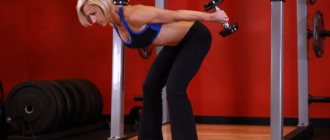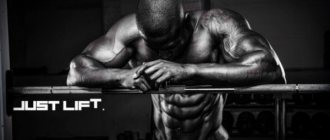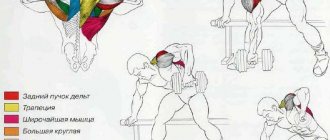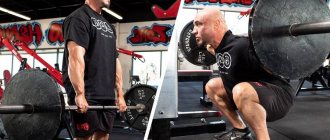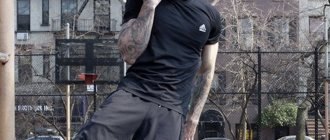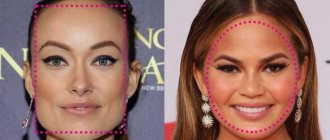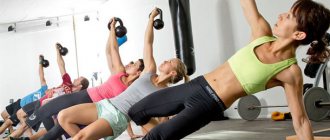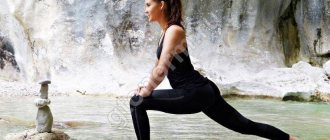The deadlift or dead lift is one of the varieties of the classic deadlift, which is so called because it is performed on straight legs, without bending the knees, literally tightly. This version of the deadlift is not a weightlifting exercise, but is widely used when building muscle mass in the gym, especially for women. This is due to the fact that deadlifts develop the gluteal muscles and hamstrings, the favorite muscles of the fairer sex, without involving the quadriceps. Next, we will consider the technique of performing deadlifts, Romanian and their main differences from the classical deadlift.
Where did these names come from?
First, let's look at the main differences between deadlifts and Romanian deadlifts. If the dead lift is performed with straight legs, then the Romanian deadlift is performed with the knees bent to about 15 degrees. The classic deadlift was the main exercise in weightlifting, and the Romanian deadlift appeared thanks to Romanian weightlifters practicing this technique. Judging by the fact that their athletes always stood out and took high places, the Romanian deadlift technique began to be used everywhere. Next, a variant of the Romanian deadlift appeared, which began to be performed with straight knees for greater stretching and involvement of the hamstrings in the work.
Essentially, the Romanian and deadlift are the same exercise, and the angle of knee flexion depends on the stretch of the hamstrings.
What is the difference between deadlift and Romanian
Both options involve bending the knees, but the difference between them is fundamental. In a classic deadlift, the movement is more similar to a squat, and the angle at the knees approaches 90 degrees. Deadlifts are performed mainly through the back, also involving the quadriceps of the thigh. In Romanian, the pelvis is primarily tilted and abducted, which is accompanied by slight bending of the knees, up to about 10-15 degrees. And the main muscles during the Romanian deadlift are the gluteal and lumbar extensors, without involving the quadriceps.
Difference between deadlift and deadlift
Two completely different movements. As already mentioned, the classic deadlift is performed with bending the knees, and the deadlift on straight legs, respectively, without bending the knees. If in the classical one the latissimus dorsi muscles, its extensors and quadriceps work to a greater extent, then in the dead one the hamstrings and gluteal muscles are subjected to great stretching, but the quadriceps do not work.
Cardio without cardio
And last but not least are the benefits of unilateral exercises for training the cardiovascular and metabolic systems. I'll never forget how out of breath I was in the middle of a set of lunges when I tried them as part of a high-volume program. My heart just jumped out of my chest, and suddenly I remembered that I had already tried this before and decided not to repeat it again. It is clear that performing the exercise separately on each leg takes twice as long as on both legs at once. In reality, it takes even more time - you slow down due to the complexity of the movement, are distracted by maintaining balance, etc.
All this means is that the time under tension is twice as long, the metabolic cost is twice as high, the gasps are twice as long and the heart beat is also twice as high as when performing the same exercise on two legs. Therefore, unilateral exercises are now always at the heart of my general physical training programs. Three or four one-legged exercises - lunges, bridges, squats and deadlifts - are performed in a row without breaks, 10 repetitions per leg in each.
The benefits and harms of deadlifts on straight legs
Thanks to the straight leg technique, the flexibility and elasticity of the muscles of the back surface of the body increases. This allows you to safely perform complex compound exercises that require a good stretch of these muscles, such as deep squats and other pulling exercises.
When the muscles of the posterior surface of the body are shortened, when they are in hypertonicity, hyperlordosis of the lumbar region, protrusion of the abdomen and forward displacement of the pelvis more often appear. Deadlifts allow you to stretch shortened muscles, return them to their normal physiological state and strengthen the stabilizers - the gluteal muscles, which are in an atonic state. Therefore, straight-legged deadlifts improve spinal health and posture.
If the muscles are too tight and experience pain when performing deadlifts on straight legs, you should replace the exercise with a safer one that does not stretch the hamstrings as much. Inelastic hamstrings - the biceps femoris, semitendinosus and semimembrane muscles are severely injured when stretched, and the technique leaves much to be desired, since it is impossible to perform the exercise with the required amplitude.
Therefore, the dead lift should be performed only if you have flexible and elastic muscle fibers.
Also, weak abdominal muscles do not allow the lower back to be fixed in a natural deflection, which causes it to become rounded. And when working with weights, there is a strong load on the vertebrae with further traumatization.
Maintaining the correct technique and position of the lower back in a natural deflection will prevent injuries and back pain.
Single leg squats and deadlifts
The author is FPA expert Sergey Strukov. Among people who regularly visit the gym of a fitness club, squats and deadlifts are popular. Of course, these are necessary and in most cases irreplaceable exercises. Squats and deadlifts can be performed on either two or one leg, with the latter receiving undeservedly little attention. We propose to consider the types of exercises on one leg, their meaning and place in the training program. Squats on one leg are performed with full or partial amplitude. It is most convenient to perform full squats while standing on a high bench or a special pedestal with a hard surface, so that you can lower your unloaded leg down relatively freely. A hard surface is required for full transmission of force during muscle contraction.
Fig 1. Partial squat on one leg. A) Starting position; B) Final position. The neutral position of the back is not maintained: the lumbar lordosis straightens somewhat, while the thoracic and cervical spine bend compensatoryly.
Fig 2. Pistol squat. A significant backward deviation of the pelvis is clearly visible, the lumbar spine is bent. If we compare with Figure 1b, we can note that flexion of the lumbar spine in this case is not compensated by extension of the thoracic spine.
It is preferable to lower the leg down (Fig. 1) rather than straighten it forward, as in the well-known pistol squat (Fig. 2). A straightened leg forward creates unnecessary tension in the hip flexor muscles (especially the iliopsoas muscle) of the “non-working” leg, and also contributes to a backward tilt of the pelvis, which can provoke muscle spasm and pain in the lower back. The depth of the squat is determined by the available range of motion and the goals of the exercise. Amplitude is usually limited by insufficient joint mobility and/or strength of the prime mover muscles. If the range of motion is limited due to illness or injury, it is necessary to maintain the available range of motion. For everyone else, full-range single-leg squats are a good way to develop “functional” strength and balance in the development of the lower extremity extensors, which are the largest muscles in the body. In the case of deliberately increasing the load on the gluteal muscles, it is advisable to perform squats with partial amplitude. To do this, it is necessary to maintain the natural curves of the spine when performing a squat without changes (especially lumbar lordosis). The squat is performed with the unloaded leg lightly touching the floor.
In gyms you can often see various types of steps onto a high bench or pedestal. Despite its popularity, the exercise has an extremely low efficiency in terms of loading the legs compared to the squat variations described above.
Scissor squats (Fig. 3) can also be classified as squats, but not on one leg, but with an emphasis on one leg. In scissors, it is important to distribute most of the load on the leg that is in front. To do this, a constant slight tilt of the body forward is introduced; the neutral position of the spine must be observed in this case as well. It is advisable to place the other leg on a rigid support, avoiding its elevation, as with the so-called “Bulgarian” squats (Fig. 4), so as not to overload the hip flexors (usually the rectus femoris muscle) from excessive tension. In addition, it is important to take a step not too wide and not to place your feet one after the other, but to place them in the frontal plane at the width of the pelvis.
Figure 3. Scissor squats (intermediate position shown). A slight forward tilt is clearly visible. The use of a Smith machine makes it easier to control the movement and allows you to maintain a vertical position of the shin of the “working” leg while performing the exercise.
Fig 4. “Bulgarian” squats with a barbell. You can clearly see how the pelvis is distorted; this creates a dangerous load on the lumbar spine. In addition, reflex contraction of the left leg flexors worsens the situation.
The single-leg deadlift is recommended to be performed as a variation of the straight-legged deadlift movement. Of course, the knee joint must be slightly bent while bending, without allowing the pelvis to drop significantly downwards (Fig. 5). The fundamental difference between any version of deadlifts and squats: in squats, conditionally, you need to lower the pelvis lower, while in deadlifts the amplitude of movement in the hip joint is significant, but the pelvis practically does not fall down. Deadlifts can be performed with symmetrical or asymmetrical weights. A barbell is usually used as a symmetrical weight, or, less commonly, dumbbells of equal weight. In this variation, the single-leg deadlift is an excellent exercise for developing the gluteus medius, minimus, and hamstring muscles. The asymmetrical version is performed with a dumbbell (weight), which is held in one hand. The load on the main propulsors is reduced, but at the same time the requirements for position stabilization increase. In some cases, you can see an embodiment in which the unloaded leg remains straight when tilted - in line with the body (Fig. 6). Correct execution involves moving the leg along the floor surface without touching or significant muscle tension. The pelvic and shoulder girdles should remain parallel to each other.
Fig 5. Deadlift on one leg. Pay attention to typical mistakes: when performing the exercise, the unsupported leg remains in one position, which unreasonably complicates control over the movement; in the starting position (Fig. A) there is a slight tilt; in the final position (Fig. B), the supporting leg is excessively bent at the knee.
Fig. 6. Incorrect execution of deadlifts on one leg with dumbbells. The leg is in line with the body (Fig. B).
Deadlift on one leg with asymmetric weights is an exercise aimed at integrating the work of the pelvic and shoulder girdles, establishing a reliable “connection” between them. Thus, this exercise is corrective. It is extremely important to maintain a neutral spine when performing deadlifts, including single-leg variations. The movement should occur in the hip joint, in the shoulder joints, plus a slight flexion of the knee, but not in the joints of the spine.
Fig 7. Gluteal muscles.
The impact of “one-legged” exercises on the musculoskeletal system determines their place in the training program. Standing on one leg creates an additional torque that brings the hip of the supporting leg, the pelvis, and with it the entire upper body. The unsupported leg acts in this case as a burden, which leads to an increase in the force that needs to be produced by the hip abductor muscles. Hip abduction is carried out by the gluteus medius and minimus muscles, respectively, these muscles receive an additional stimulus for development. The single-leg deadlift is the best exercise for this region (see Figure 7). Weakness of the abductor muscles causes the pelvis to drop on the side opposite the supporting leg, and is also the main cause of knee constriction in double-legged squats. In all of these variations, single-leg exercises place increased demands on balance, and are thus an integral part of programs to improve motor coordination. Another common benefit of single-leg squats and deadlifts is their ability to correct muscle development imbalances on the right and left sides of the body.
I will list the main muscles that are affected when performing the above mentioned exercises on one leg:
- full squat – quadriceps femoris;
- partial squat or scissor squat (maintaining a neutral position) – gluteus maximus and quadriceps muscles;
- deadlift - middle, small and large (to a lesser extent) gluteal muscles, muscles of the back of the thigh, adductor magnus.
I would also like to draw attention to the fact that it is advisable to perform exercises on one leg in a relatively high number of repetitions, on average 8–10, the time the muscles are under load is 20–60 s. The emphasis should be placed not on the size of the weight, but on safe execution technique.
A confident full single-leg squat shows good leg muscle development and can complement a training program, especially where there is a strength difference between the limbs. A partial squat until the thigh is parallel to the floor, with control of the position of the pelvis, or a scissor squat is included in the program to target the gluteus maximus muscles, as a main/auxiliary exercise for developing the strength of the leg extensors. Deadlifts on one leg are necessarily included in programs to improve coordination of movements, improve stabilization of the pelvis in the frontal plane, for the functional and aesthetic completeness of the development of the gluteal muscles.
What muscles work
Main muscles:
- Spinal extensors.
- Large gluteal muscles.
- Biceps femoris muscles.
Stabilizing the spine also involves the rectus abdominis, trapezius, and forearms.
Technique for performing deadlifts with a barbell
- Place the barbell in the power rack at hip level, select a suitable load weight, do not take too much weight, as this will injure the hamstrings.
- Grasp the bar with an overhand grip, shoulder-width apart.
- Remove the bar, take a couple of steps back and place your feet hip-width apart, parallel to each other.
- Look in front of you, gather your shoulder blades and tighten your abdominal muscles.
- As you inhale, tilt your body forward while simultaneously moving your pelvis back without bending your knees. The body weight should shift to the heels.
- Your back should be in a slight arch; to do this, pull your tailbone back and tense your abs. Arms straight and relaxed.
- The forward tilt of the torso depends on the degree of muscle flexibility; it is enough to lower the bar, which runs straight along the hips, to approximately the middle of the shin.
- As you exhale, push off with your heels and straighten your straight back in reverse order using your gluteal muscles and lumbar extensors.
- At the top point, straighten up completely.
- Continue the movement for the required number of repetitions without experiencing any acute pain. At the end of the set, return the bar to the power rack.
Unique secrets of “power” deadlifting for powerlifters
The theoretical methodology itself cannot be ideal, since the athlete may have many questions about the details of the exercise. It is for this purpose, based on monitoring common questions among powerlifters, that this section was created.
Complete your exercise with the following nuances:
- Never perform this exercise without warming up your muscles. Do deadlifts after your body has warmed up through your regular workout routine; — The starting position of the body is the athlete’s stance, shoulder-width apart, with the toes of the feet under the bar; — The grip of the bar must be wider than the position of the legs. In this case, use a different type of grip, grab the bar with one hand from above and the other from below. - Watch your back. When performing a “power” pull, the back should always remain straight. If during this exercise you notice that your back begins to round, then you should additionally select a set of exercises that will help train your back flexibility. — Always maintain a balanced (stable) posture, do not make sudden movements. Perform all phases of the deadlift as smoothly as possible, without sudden jolts.
For those who have already tried deadlifts! You can only increase the weight of the barbell when you have thoroughly honed your deadlift technique. To do this, you need to consult with a powerlifting coach.
Romanian Deadlift Technique at Smith
The above technique can also be performed in Smith. Using an example, let's look at the Romanian deadlift with bent knees. The Smith machine makes it easier to perform deadlifts because the bar is mounted on guides, making it easier to control pelvic abduction and tilt.
- Place the bar on the clamps of the machine at hip level.
- Stand in the center of the bar and grab it from above, shoulder width apart. Turn the locks and remove the bar from the clamps.
- There is very little distance between the feet and the bar; the bar should slide along the shin. Place your feet parallel to the width of your pelvis.
- Look in front of you and, as you inhale, tilt your body, moving your pelvis back and at the same time bending your knees, but not too much; the exercise is performed as a tilt, not a squat.
- Bring the bar to its maximum point at the bottom, but do not round your back. The inclination depends on the degree of muscle stretching.
- Exhale and straighten your torso, knees and pelvis in the upper position.
- After completing the approach at the top point, rotate the bar and secure.
Theory is no match for practice
Even in the case of a detailed, fairly deep and long-term study of the theory of performing the “deadlift”, it is impossible to master it without the help of a clear example. In the case of this basic powerlifting exercise, professional assistance is required. Only a trainer who has an impeccable command of the deadlift technique will be able to demonstrate to you how to do it correctly. Also, the powerlifting coach performs the function of monitoring the athlete’s actions. He will be able not only to point out the mistakes of an athlete performing a strength exercise, but also to correctly correct each movement to achieve an ideal result.
Theory remains just information. Only in practice can you realize your sports dream - mastering complex “power” deadlifts is absolutely safe for health, and in a fairly short time (in express mode). Attention! Training on your own can lead to injury and will also take up too much time. In addition to all this, self-training for athletes is a big risk. That is why professional help is the best way to harmoniously master the “deadlift” technique.
Deadlift technique in a crossover
Deadlifts and Romanian deadlifts are also performed in the lower block of the crossover. Of course, the barbell is the most preferred equipment, as it is a free weight. The lower block is not designed for vertical movement of the handle along the shin, so you have to move back; accordingly, the block pulls your arms forward and pulls the body behind it.
- Grab a straight handle shoulder-width apart while facing into a crossover.
- Take a few steps back while pulling on the cable.
- Place your feet hip-width apart, tighten your abs and keep your lower back in a natural arch throughout the entire approach.
- As you inhale, tilt your body forward, moving your pelvis back, transferring your center of gravity to your heels. Don't bend your knees. The arms are freely extended behind the block with the handle, but it is important to ensure that the weight does not pull the body forward and does not shift the load to the toes.
- As you exhale, straighten your torso, pushing off with your heels, and fully straighten all joints at the top point.
Stretching
If you include deadlifts in your program, you should perform the following stretches after your workout.
Hamstring stretch
There are several options for stretching the hamstrings. Let's look at two of them: with an elastic band and using a barbell.
1. Sit on the floor, straighten your knees and reach for your toes with your back straight. It is convenient to perform this exercise with a rubber band, but you can do without it: just reach your toes with your hands without bending your knees.
Hamstring stretch with rubber band
2. Another good option is to stretch with your leg on an elevated platform, such as on a barbell. Place your foot on the bar, straighten both knees and your back. If there is not enough load, try to tilt your body straight towards your leg.
Hamstring stretch on the bar
Gluteal stretch
When you stretch your hamstrings, your gluteal muscles also stretch. But you can do additional exercises to enhance the effect.
Here are two options for stretching the gluteal muscles: lying down and sitting. Try to pull your shin as close to you as possible, keeping it parallel to the floor.
Gluteal stretch
That's all. If you have your own tips and comments about the deadlift technique, please share them in the comments.
Recommendations: how to perform deadlifts for girls and men
Both men and women are not recommended to perform deadlifts with maximum weights, since the biceps and ligaments already experience severe stretching; they should not be injured by working weights as in the classic deadlift. Think of the dead lift as an auxiliary exercise to tone your biceps and glutes. Perform it extremely carefully within 15-25 repetitions of 3 sets.
More trained representatives of the stronger sex can perform the exercise for 12-14 repetitions of 3-4 approaches. The exercise should only be performed after compound compound exercises that involve more muscles, such as barbell squats and leg presses.
If the exercise causes severe pain in the hamstrings, replace it with the Romanian deadlift, which will relieve the stretch.
Execution options
Deadlifts can be performed:
| With a barbell | An option that is the main one for many athletes. A deadlift with a barbell gives a good load to the back, but only if, when lowering the barbell, you move the bar along your legs without bringing it forward. So, first of all, the buttocks and hamstrings will work. |
| With dumbbells | This option has an important advantage compared to barbell rows - the hands are located in a more natural position, so there is no unnecessary stress on the muscles and joints of the hands. For some athletes, for example, those with hand injuries, this option is the only option. The advantage is that it puts a more serious load on the hamstrings and gluteal muscles. |
In almost all gyms, this exercise is performed on two legs, but there is also an option to perform it on one leg: you need to take a barbell, lift one leg, bending it at the knee at an angle close to 90 degrees. While bending forward, move your raised leg back, straightening it at the knee to maintain balance. You can try doing it with weights - this will make it easier to retract your shoulder blades.
Grip options
There are three grip options when performing this exercise:
- Straight.
- Back.
- Multidirectional, or multi-grip.
The latter assumes that one hand is placed with a direct grip, and the other with a reverse grip. Which of these options to prefer is mostly a matter of taste. Every athlete has a favorite grip that is familiar to him.
You can do deadlifts by standing with your toes on two plates. This allows you to maximally load the gluteal muscles and hamstrings. Typically this option is used when performing deadlifts with dumbbells.
How to replace dead rods at home
At home, if you don’t have a barbell, you can perform the exercise with dumbbells, kettlebells, fitness bands and balls.
Deadlift with elastic band
Both a rubber band and an expander ring band are suitable for this exercise. It is necessary to step with your feet on the lower edge of the ring elastic or the middle of the tape, selecting a certain degree of tension, and grab the free edges. The stronger the stretch, the stronger the load. When you bend down, the band contracts, and when you straighten your torso, it creates the necessary resistance.
Deadlift with dumbbells
The technique remains the same; you need to hold dumbbells in both hands, placing them in front of your hips with your palms facing you.
Deadlift with kettlebell
The handle of the kettlebell must be held with both hands, taking the starting position, as in the deadlift with a barbell.
Read more about kettlebell deadlifts →
Deadlift with medicine ball
The medicine ball serves as a weight depending on its weight. To perform the exercise, hold the ball between your palms at your sides. Rowing with the ball occurs in the same way as with a barbell; the ball slides along the shin.
The best exercises with a medicine ball →
What is a Romanian Single Leg Deadlift?
You probably already know what a deadlift is. There is a barbell on the floor and you bend over to lift it. You start in the finishing position of a classic deadlift (standing tall, hips locked) and then bend your hips back, allowing your knees to bend until you feel your hamstrings stretch. The Romanian deadlift is a one-sided version of this movement.
Like other deadlifts, the single-leg RDL is a hinge movement—the primary training effect comes from hip flexion and extension. Single leg RDL can be done with a barbell, one or two dumbbells/kettlebells, a steel mace, a sandbag, or just about any other training tool you like.
You stand on one leg, hold a weight in one (or both) hands, and bend your hips back while maintaining a straight spine. The movement works the entire back side of the body (called the posterior chain), developing balance and improving mobility in the hips.
Due to its versatility, the Romanian single leg deadlift can be used in any training program, from warm-up to final workout.

